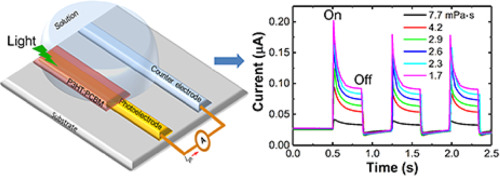Electrochemistry Communications ( IF 4.7 ) Pub Date : 2018-08-31 , DOI: 10.1016/j.elecom.2018.08.017 Zichang Su , Rui Feng , Laigui Hu , Hanqiu Yi , Cheng Chen , Yajie Qin , Guoping Chen , Zhi-Jun Qiu , Chunxiao Cong , Ran Liu

|
Most viscosity sensors, which are important in the health, automotive and food production industries, are currently based on mechanical or optical approaches. They are not compatible with emerging flexible and wearable electronics consisting of various lightweight integrated sensors with more compact architecture and lower cost. Here we demonstrate an organic device for sensing the viscosity of nonelectrolyte aqueous solutions which can work at low viscosities (0.9–10 mPa·s). The photoconductivity of devices involving semiconductor/water interfaces was found to obey Walden's rule, suggesting that viscosity could be measured by electrical means. This may be a promising approach for the design of viscosity sensors for portable and wearable applications.
中文翻译:

有机半导体/水界面用于光电粘度传感
在健康,汽车和食品生产行业中非常重要的大多数粘度传感器目前都基于机械或光学方法。它们与新兴的柔性和可穿戴电子设备不兼容,后者由各种轻型集成传感器组成,具有更紧凑的结构和更低的成本。在这里,我们演示了一种可检测非电解质水溶液粘度的有机装置,该装置可以在低粘度(0.9-10 mPa·s)下工作。发现涉及半导体/水界面的器件的光电导性符合沃尔登法则,表明可以通过电学方法测量粘度。对于用于便携式和可穿戴应用的粘度传感器的设计,这可能是一种有前途的方法。







































 京公网安备 11010802027423号
京公网安备 11010802027423号